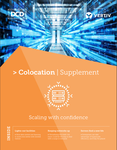Multi-tenant data centers (MTDCs) around the world have experienced prolific growth that shows no signs of slowing. As data center services are becoming the fifth utility, joining electricity, gas, water and telephone networks, the industry faces unprecedented growth demands but also extraordinary pressures to keep both OpEx and CapEx in check.
And traditional data centers are taking their cues from the biggest players on the stage in three key areas: global standardization, modular power, and tightening up the links in the power chain.
Global standardization
In high-velocity growth situations, MTDCs can save deployment and planning time by standardizing their implementations across the globe. With this consistent use of the same products and configurations, they eliminate the re-work in design and shrink deployment timelines. The ability to specify the same products or configurations anywhere in the world brings a level of comfort and familiarity that is especially valuable when you are entering a new-to-you, secondary market, as is very much the current trend.
The same concept is true within a single facility. Standardization saves time and money. From both MTDCs and enterprises, we are seeing more RFPs that prioritize global standardization, as it’s one of the few remaining areas to trim time and costs from already lean operations.
Modular power
From global MTDCs to individual data centers, they all intrinsically want to buy only what they need, which is why modular power has become a leading strategy. But power protection can be modular in many dimensions.
The Vertiv™ Liebert® Trinergy™ Cube uninterruptible power supply (UPS), for example, is modular in three dimensions. Vertically, the stacked drawers in each core can be individually extracted for service while the UPS continues to protect the load. Horizontally, the system can be scaled up to 1.6 megawatts (MW) by adding up to four individual 400-kilowatt (kW) cores, and optionally a fifth core for 400 kW of redundancy. And orthogonally, up to eight fully-loaded, 1.6 MW cubes can operate in parallel to support a 12.8 MW load.
We are also seeing more demand, especially in today’s edge-to-core world, to assemble and test all solutions off site with the goals of minimizing work and reducing the number of people needed for the on-site stick build. This production, not construction approach lowers total cost while improving quality and enabling predictable schedules. Complete prefabricated modular solutions lead the way in this regard, but no solutions are outside the trend, including power systems.
Rightsize and minimize the links in your power chain
Purchasing organizations of large MTDCs are well intended but have historically subscribed to a common practice that hurts utilization and drives up cost: buying based on lowest common denominator versus optimal kilowatt sizes. For example, specifying an 800-kW UPS system costs less per kilowatt upfront than a 750-kW system. Since the breakers in the gear are the same for systems between 750 and 800 kW, if a 750-kW system is selected, the MTDC is leaving 50 kW on the table and increasing system cost per kilowatt.
While customers are increasingly evaluating systems based on cost per kilowatt, I’m not shy about telling them about a misstep that strands capacity and increases their energy costs.
There are opportunities to rescue stranded capacity at every step in the power chain to get the most from your equipment. Matching capacities across the chain – input board, output board, static transfer switch, UPS – brings you maximum utilization. Anything else strands capacity.
You also can reduce your part count through the products you choose. For example, with the Liebert Trinergy Cube, additional capacity can be added onto the core, minimizing the complexity of traditional multi-module system designs. The design of the system enables batteries to scale with the power cores for true, incremental growth and allows unneeded cores to be idled during periods of low demand for maximum utilization and peak efficiency.
Get what you need
I often talk to customers as they are specifying their power system, and when we discuss these approaches to eliminating stranded capacity and lowering the cost per kilowatt, they question why I’m trying to sell them less equipment. I tell them I’m trying to sell them the right amount of equipment, and when they need more, we’ll be happy to sell them more.
Explore this interactive infographic to learn more about the benefits of using Liebert Trinergy Cube, the industry’s most flexible modular UPS system.





